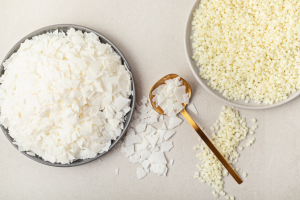More and more people pay attention to the composition of the products they choose, including foodstuffs, chemicals or personal care products. However, even if you know the names of many substances, you may not be aware of their applications. Wax is a good example, especially the plant waxes. Learn about their types and numerous properties.

Plant wax applications
How to identify a vegan beauty product? This is a question asked by an increasing number of consumers, in line with the growing interest in organic products and natural cosmetics – see: raw materials for natural cosmetics. It is specifically for this reason why plant wax has begun to replace beeswax or paraffin in many products. Even though you may only associate these substances with candles and rinse aids, we are about to change that!
Waxes of vegetable and animal origin are water-insoluble substances whose texture depends on the product’s storage temperature. The key property of these ingredients is to add gloss and shine. For this reason, they are readily used for the production of cosmetics and cleaning agents. In addition, they extend the shelf life of specific products and support lubricity of ointments and creams.
However, there are many more uses of plant waxes. They include:
- production of skin care and make-up products, such as creams, lip balms and mascaras,
- making of would healing ointments,
- developing formulations for shine-enhancing products, such as surface cleaning agents,
- production of natural candles.
Like beeswax, vegetable waxes can also perform protective functions, which makes their properties more attractive for cosmetics manufacturers.
See cosmetic formulations straight from the manufacturer, the PCC Group.
Examples of vegetable waxes you can find at home
If you make sure the products you buy are ‘organic’, you are very likely to find vegetable waxes in their composition. The simplest answer to the question how organic cosmetics are made is to use vegan, organic and certified substances. The most popular names of vegetable waxes you can find on the packaging of your cosmetics and home cleaning agents include:
- jojoba oil (body and hair care cosmetics),
- carnauba wax (sunscreens, lipsticks, mascaras),
- candelilla wax (shoe polishes, lotions, stick perfumes),
- soy wax (candles, aromatherapy products),
- palm wax (candles, emollient cosmetics).
Vegetable waxes are substances that are friendly to human health and natural environment. It is therefore worth to know which ones to choose and when – and which products they can substitute.

Vegetable wax for candles
Natural candle wax has become very popular in recent years. Some people decide to make candles on their own while others seek businesses specialised in sourcing environmentally friendly materials. The commonly known paraffin is cheap, but as a petroleum product, it conflicts with the idea of sustainability. Fortunately, there are quality alternatives, including soy wax for making candles.
- This type of vegetable wax works well for candle making because of its burning time.
- It does not contain toxic substances, which makes candles made of soy wax safe for humans and animals. It is also biodegradable.
In the category of vegetable waxes for candles, products derived from soybeans remain a clear winner because of their price and properties. Especially given that palm wax extraction is highly controversial and leads to the destruction of rainforests, while coconut wax usually needs to be combined with other substances to achieve the desired result. In addition, it is rather pricey compared to other vegetable waxes aimed for candles.
Vegetable waxes in cosmetics
Waxes sourced from plants work well as ingredients in skin care and make-up products. They are also more frequently sold as a separate product, enabling customers to make their own natural cosmetics.
Both pure and scented vegetable waxes are available on the market. You can find them primarily in:
- emollient creams,
- softening body lotions,
- medicinal ointments,
- hair care products (including hair wax for easy styling),
- make-up cosmetics (usually lipsticks).
Vegetable wax can also be used as a stabilising agent (perfect for emulsions) or a substance that adds desired texture to products.
Read also about other cosmetic intermediates.
Why use vegetable waxes?
Vegetable wax is a safe and natural substance that can be used in many ways. By choosing products that contain soy wax or jojoba oil in their composition, you are not only taking care of your health, but also the condition of our planet. This is because natural plant extracts are a safe alternative to artificial substances. With its pure composition and aromatherapy properties, vegetable wax can have a beneficial effect on your mood.
Buying cosmetics that contain natural wax is a step towards a healthy, environmentally-friendly lifestyle. They can also be a great gift for your loved ones. Check out the range of organic chemicals and environmentally-friendly products from PCC Group to make a good choice today.
- Rubinowska, K. Naturalne surowce pochodzenia roślinnego w kosmetykach do makijażu, od starożytności do współczesności, https://up.lublin.pl/wp-content/uploads/2022/01/Wybrane-aspekty-biokosmetologii_.pdf#page=10
- Guziałowska-Tic, J. (2013). Charakterystyka surowców do produkcji świec i zniczy oraz ich wpływ na środowisko. Chemik, 67(10), 1027-1034, https://bibliotekanauki.pl/articles/1208126.pdf.
- Goik U, Goik T., Załęska I., Właściwości wosku pszczelego i jego zastosowanie w kosmetyce i kosmetologii, Kosmetologia Estetyczna 2016, t. 5, nr. 6, s. 617-622
- Tsuji S., Tonogai Y., Ito Y., General analysis of various natural waxes in cosmetics, Journal of Society of Cosmetic Chemists of Japan 1985, t. 19, n. 2, s. 79-89
- Kopczyńska D, Klasik-Ciszewska S., Duda-Grychtoł K., Produkty pszczele w pielęgnacji skóry, Medycyna Rodzinna, Borgis 2018, nr. 1, s. 48-52
